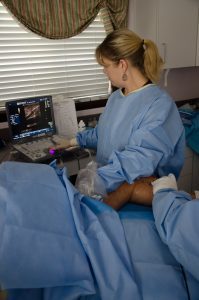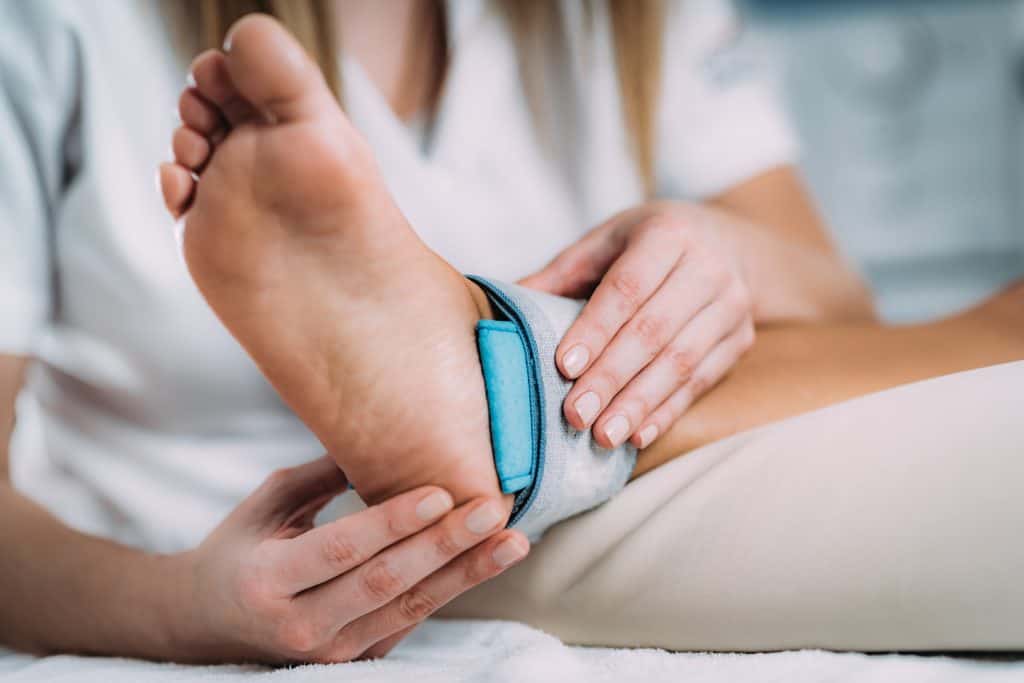
Pain Management
Safely Managing Pain After Surgery

To avoid the overuse of opiods, patients and surgeons are more interested in alternative methods like acupuncture in addition to the other usual forms of medications. We like to individualize each patients post-op plan and have found a combination of methods gives the best results.
Alternative Approaches to Pain Management
Focus on the alternative approaches doctors use for your pain management.. To learn more about opiods and other medicines used to control pain after orthopaedic surgery: Managing Pain With Medications After Orthopaedic Surgery
K-Laser
K-Laser, also known as High Power Laser Therapy, targets damaged tissue with specific wavelengths of light that have been found to interact with tissue and accelerate the healing process.
https://youtu.be/BDbinBmPNIA
TENS (Transcutaneous Electrical Nerve Stimulation)
During this treatment, a special device will elicit a low-level electrical charge into the area of the body that is experiencing pain.
A TENS unit is a small, battery operated machine with wires connected to electrodes. These electrodes connect near the area of pain or at the site of the pressure point. It delivers a mild electrical current to your skin and along the nerve fibers.You may feel a warm and tingling sensation. Treatment using TENS usually lasts 15-30 minutes per area per treatment.
Much research suggests that TENS is useful in easing pain following surgery. Also, it can be helpful to some who experience chronic low back pain. Usually, it is considered safe but the routine use of TENS is not recommended.
How does TENS Work?
Gate Control Theory: For us as humans to be able to feel pain, the sensation must pass a gate to get to access the brain. If the electrical current is absent, the pain is able to freely pass through a gate to enter the brain. When the electrical current is applied to these gates, it will achieve a threshold limit and will be unable to allow pain sensations to pass through.
Release of Endogenous Opiates: Some scientists believe that the method in which TENS works by is related to the neurons. Our body’s neurons release more of our body’s natural pain killers called “endorphins.” In conclusion, this will cause the body to feel pain.
Central Inhibitory Effect: TENS may also alter the way that the brain perceives and processes pain.
When to Avoid TENS
TENS may not work well for you if your pain is elicited by mental/emotional problems. Also, if you struggle with drug addiction, the TENS method will not work well.
TENS should not be used if you have any of the following conditions:
- Implanted medical device (defibrillator or pacemaker)
- Pregnancy
- Epilepsy
- Mental retardation
- Undiagnosed pain
PENS – percutaneous electrical nerve stimulation
There is also an acupuncture version of TENS in which the electrical impulses are delivered to the needles rather than the original TENS method of electrode pads. This method is referred to as PENS (percutaneous electrical nerve stimulation.
CONTINUOUS PASSIVE MOTION
Continuous Passive Motion (CPM) is a technique utilized in which your joint is constantly in a mechanical splint to decrease stiffness and increase ROM. Fortunately, a CPM machine will assist your joints through the motion while preventing you from exerting your own effort.
Medical evidence supports the use of immobilization of joints will increase one’s pain level following surgery. In addition, early motion is applied to orthopaedic injuries following surgeries/procedures. Continuous Passive Motion is thought to be effective in treating conditions s
- Cartilage damage
- A bacterial infection inside a joint
- A fracture around a joint after it has been fixed with internal devices
This method of treatment is believed to enhance nutrition to your joints, discourage scar tissue formation, and prevent the shortening of muscles around the joint capsule.
CPM
If you are able to move either passively or actively without the use of CPM, then you will not benefit from using this device. Also, this method is not to be used as a replacement for a trained individual such as your physical therapist. If the method of CPM is recommended by your healthcare provider, you will also be monitored by your physical therapist.
Acupuncture points are associated with areas of the skin that contain large amounts of intersecting nerve endings that innervate your muscles. Some scientists believe that the points known as “acupoints” contain special characteristics that can be manipulated using the painless hair-thin needles.
A typical acupuncture session may last for about 30 minutes. These treatments are used to relieve local pain and swelling, and provide a feeling of relaxation due to the release of endorphins. As stated previously, these endorphins are our body’s natural painkillers.
It is essential to communicate with the acupuncturist on which areas of your body are producing pain. As a result, they can pinpoint the exact location to apply the painless needles.
Psychological Methods
Psychological methods can also be implemented as an additional treatment for pain management. Some of these methods can reduce or eliminate the need for medication. The best and oldest documented methods of treatment are as follows:
- Relaxation techniques
- Guided imagery
- Medical hypnosis
In the 18 conducted medical studies, methods such as medical hypnosis, guided imagery, or relaxation techniques were used to improve recovery following surgeries. In 16 of these studies, researchers concluded and documented improvements in both the physical and emotional recoveries of patients.
These results concluded that these psychological methods are effective as an additional treatment for pain management and recovery. Such methods appear to have much potential in orthopaedic surgery that could reduce pain level, enhance outcomes following treatment, and possibly reduce medical costs.
Home Remedies To Manage Pain After Surgery
1. Avoid Staying At The Same Place For Too Long
Spending your time sitting not laying down for too long can increase the pain.
Everyday getting up, walking, or performing any small activity can help you prevent stiffness in the treated area along with blood clots.
Its true that sometimes its hard to move because of the pain so many people don’t want to try any of these activities but this isn’t good at all.
If you can’t perform such simple activities then you should immediately inform your doctor.
2. Take Your Pain Relievers On The Right Time
You shouldn’t wait until your pain increases or becomes severe, if you have a little pain then you should take your medicines.
Your doctor must have provided you with a schedule for taking medicines, so you must consume your pain relievers according to it.
If you don’t take medicines on the time then it may be hard for you to deal with the pain later especially because medicines take time to show their effect.
No one likes taking medicines again and again so when your pain decreases you should ask your doctor to decrease the doses as well!
3. Lavender Oil
Lavender oil is an essential oil and its main use is reliving pain naturally!
It can be used to get rid of pain after surgery, help you sleep if you can’t sleep because of the pain and it can help you ease anxiety as well!
Furthermore, lavender oil has some anti-fungal and bacterial properties too which can help you prevent infections after the surgery.
You can massage the treated area gently with the oil or you can add it in your bath just make sure you don’t consume it as it can be toxic.
How does sleep quality impact pain perception, and are there strategies for improving sleep in pain management?
Sleep quality can significantly impact pain perception, and disruptions in sleep patterns may exacerbate the experience of pain. Here’s how sleep and pain are interconnected, along with strategies for improving sleep in pain management:
1. Bi-Directional Relationship:
The relationship between sleep and pain is bidirectional. Pain can interfere with sleep, and poor sleep can heighten sensitivity to pain.
2. Impact on Pain Threshold:
Inadequate or poor-quality sleep may lower the pain threshold, making individuals more susceptible to pain sensations. This can contribute to heightened pain perception.
3. Altered Pain Processing:
Sleep deprivation can alter the way the brain processes pain signals, leading to increased discomfort and sensitivity. 4. Hormonal Changes: Sleep disturbances affect hormonal regulation, including increased levels of stress hormones. These hormonal changes can influence pain modulation.
Can mindfulness and relaxation techniques aid in pain relief?
Yes, mindfulness and relaxation techniques can be effective in providing pain relief and managing chronic pain. These approaches focus on cultivating awareness, promoting relaxation, and changing one’s relationship to pain. Here are some ways in which mindfulness and relaxation techniques can contribute to pain relief:
1. Stress Reduction: Mindfulness and relaxation practices help reduce stress and tension, which can contribute to the experience of pain. Stress management is crucial in alleviating physical discomfort.
2. Increased Pain Tolerance: Mindfulness can enhance one’s ability to tolerate pain by fostering a non-judgmental awareness of sensations. This shift in perception can lead to a more balanced response to pain.
3. Improved Emotional Well-being: Mindfulness practices encourage acceptance and acknowledgment of emotions related to pain. This emotional awareness can contribute to better overall psychological well-being.
4. Focus on the Present Moment: Mindfulness emphasizes staying present in the moment rather than dwelling on past pain experiences or anticipating future disc
omfort.


